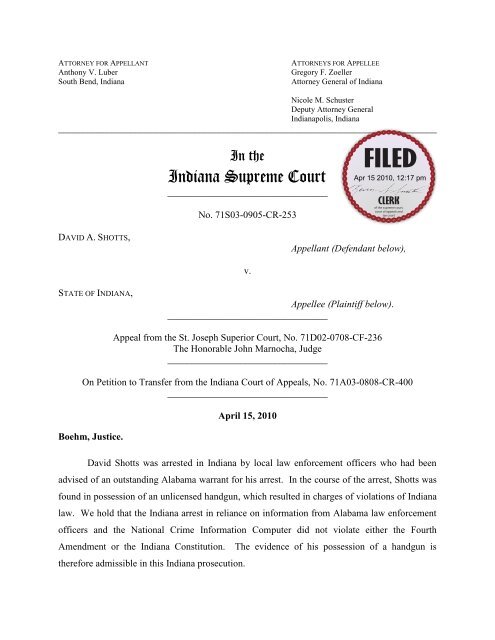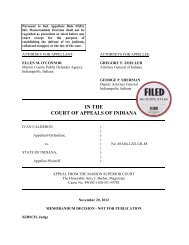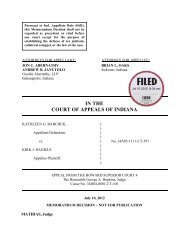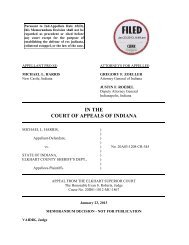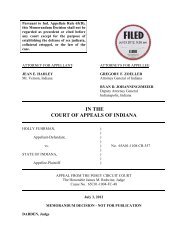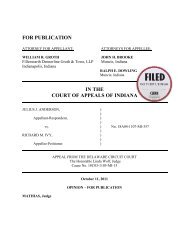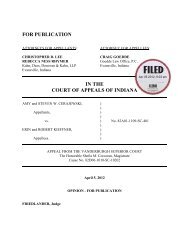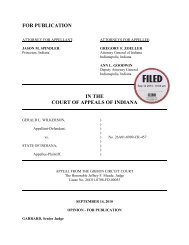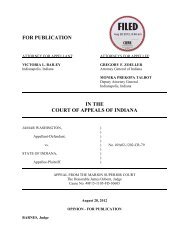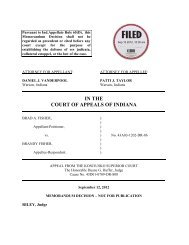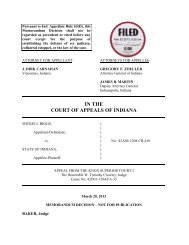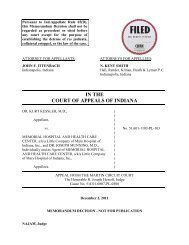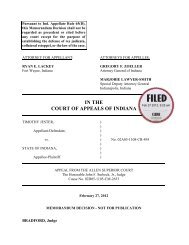David A. Shotts v. State of Indiana
David A. Shotts v. State of Indiana
David A. Shotts v. State of Indiana
Create successful ePaper yourself
Turn your PDF publications into a flip-book with our unique Google optimized e-Paper software.
ATTORNEY FOR APPELLANT<br />
Anthony V. Luber<br />
South Bend, <strong>Indiana</strong><br />
ATTORNEYS FOR APPELLEE<br />
Gregory F. Zoeller<br />
Attorney General <strong>of</strong> <strong>Indiana</strong><br />
Nicole M. Schuster<br />
Deputy Attorney General<br />
<strong>Indiana</strong>polis, <strong>Indiana</strong><br />
______________________________________________________________________________<br />
In the<br />
<strong>Indiana</strong> Supreme Court<br />
_________________________________<br />
No. 71S03-0905-CR-253<br />
DAVID A. SHOTTS,<br />
Appellant (Defendant below),<br />
v.<br />
STATE OF INDIANA,<br />
Appellee (Plaintiff below).<br />
_________________________________<br />
Appeal from the St. Joseph Superior Court, No. 71D02-0708-CF-236<br />
The Honorable John Marnocha, Judge<br />
_________________________________<br />
On Petition to Transfer from the <strong>Indiana</strong> Court <strong>of</strong> Appeals, No. 71A03-0808-CR-400<br />
_________________________________<br />
Boehm, Justice.<br />
April 15, 2010<br />
<strong>David</strong> <strong>Shotts</strong> was arrested in <strong>Indiana</strong> by local law enforcement <strong>of</strong>ficers who had been<br />
advised <strong>of</strong> an outstanding Alabama warrant for his arrest. In the course <strong>of</strong> the arrest, <strong>Shotts</strong> was<br />
found in possession <strong>of</strong> an unlicensed handgun, which resulted in charges <strong>of</strong> violations <strong>of</strong> <strong>Indiana</strong><br />
law. We hold that the <strong>Indiana</strong> arrest in reliance on information from Alabama law enforcement<br />
<strong>of</strong>ficers and the National Crime Information Computer did not violate either the Fourth<br />
Amendment or the <strong>Indiana</strong> Constitution. The evidence <strong>of</strong> his possession <strong>of</strong> a handgun is<br />
therefore admissible in this <strong>Indiana</strong> prosecution.
Facts and Procedural History<br />
On the morning <strong>of</strong> August 16, 2007, Detective Randy Kaps <strong>of</strong> the St. Joseph County,<br />
<strong>Indiana</strong>, Police Department received a call from Detective Pete Hose <strong>of</strong> the Madison County,<br />
Alabama, Sherriff‘s Department in Huntsville. Hose told Kaps that the previous day the<br />
Huntsville Police Department had obtained a felony arrest warrant for <strong>David</strong> <strong>Shotts</strong> and that<br />
<strong>Shotts</strong> was believed to be in Mishawaka in St. Joseph County, <strong>Indiana</strong>. Kaps confirmed through<br />
the National Crime Information Computer (NCIC) that there was an active Alabama arrest<br />
warrant for <strong>Shotts</strong>. Kaps then contacted Corporal Daniel Wisniewski <strong>of</strong> the St. Joseph County<br />
Warrants Division and <strong>Indiana</strong> <strong>State</strong> Trooper Mike Robinson. Wisniewksi and Robinson<br />
verified the Alabama warrant for <strong>Shotts</strong>‘s arrest in the NCIC, obtained his Mishawaka address<br />
from the <strong>Indiana</strong> Bureau <strong>of</strong> Motor Vehicles (BMV), and established surveillance <strong>of</strong> his<br />
residence. Because <strong>Shotts</strong> was believed to be armed, Kaps arranged for a SWAT team to be on<br />
standby.<br />
After meeting with Wisniewski and Robinson at the stakeout, Kaps returned to his <strong>of</strong>fice<br />
to prepare an <strong>Indiana</strong> warrant authorizing entry into <strong>Shotts</strong>‘s home. While Kaps was still in his<br />
<strong>of</strong>fice, Wisniewski and Robinson saw <strong>Shotts</strong> leave his apartment. <strong>Shotts</strong> was identified from a<br />
BMV photograph and arrested as he began to drive out <strong>of</strong> the parking lot <strong>of</strong> the apartment<br />
complex. As <strong>Shotts</strong> exited his car, the <strong>of</strong>ficers observed a revolver in a holster on his right hip.<br />
It was later determined that <strong>Shotts</strong> had no license for the handgun, and had been convicted <strong>of</strong><br />
attempted theft in Alabama in 1999.<br />
The Alabama warrant was based on a theft and a murder in Alabama. Because <strong>Shotts</strong><br />
was found with an unlicensed firearm, he was also charged with two violations <strong>of</strong> <strong>Indiana</strong> law:<br />
class A misdemeanor possession <strong>of</strong> a handgun without a license and class C felony possession <strong>of</strong><br />
a firearm by a convicted felon. Ind. Code §§ 35-47-2-1, -23(c) (2004). <strong>Shotts</strong> filed a pretrial<br />
motion to suppress the evidence <strong>of</strong> his handgun possession, arguing that the <strong>Indiana</strong> <strong>of</strong>ficers<br />
arrested him without ―any warrant or legal authority,‖ and that the subsequent search was the<br />
product <strong>of</strong> an arrest that violated both the Fourth Amendment and Article 1, § 11 <strong>of</strong> the <strong>Indiana</strong><br />
Constitution. Specifically, <strong>Shotts</strong> argued that the affidavit supporting the Alabama warrant did<br />
not establish probable cause to arrest him and therefore the Alabama warrant was facially<br />
2
deficient under Kinnaird v. <strong>State</strong>, 251 Ind. 506, 242 N.E.2d 500 (1968). After a hearing, the trial<br />
court denied <strong>Shotts</strong>‘s motion, finding the <strong>of</strong>ficers acted in good faith in arresting <strong>Shotts</strong> on the<br />
basis <strong>of</strong> the NCIC information. In a bench trial, <strong>Shotts</strong> was convicted <strong>of</strong> violating <strong>Indiana</strong><br />
firearm laws after the parties stipulated to the Alabama arrest warrant, Wisniewksi‘s police<br />
report, the booking report, a lab fingerprint report, and <strong>Shotts</strong>‘s prior Alabama conviction.<br />
<strong>Shotts</strong> appealed, contending that the Alabama warrant was defective and therefore the<br />
trial court erred in denying his motion to suppress and admitting the evidence <strong>of</strong> his weapon<br />
possession. The Court <strong>of</strong> Appeals agreed, reasoning that the affidavit supporting the Alabama<br />
warrant ―merely alleged that <strong>Shotts</strong> had committed a crime‖ and ―did not provide any facts from<br />
which a neutral magistrate could have drawn his own conclusion as to the existence <strong>of</strong> probable<br />
cause.‖ <strong>Shotts</strong>, 907 N.E.2d at 137. Based on this shortcoming, the Court <strong>of</strong> Appeals reasoned<br />
that although the <strong>Indiana</strong> <strong>of</strong>ficers acted in good faith, the Alabama <strong>of</strong>ficer who obtained the<br />
warrant on the basis <strong>of</strong> a facially defective affidavit did not. Id. at 138–39. As a result, the<br />
good-faith exception was inapplicable. Id. We granted transfer.<br />
Standard <strong>of</strong> Review<br />
The standard <strong>of</strong> appellate review <strong>of</strong> a trial court‘s ruling on a motion to suppress is<br />
similar to other sufficiency issues. Litchfield v. <strong>State</strong>, 824 N.E.2d 356, 358 (Ind. 2005). We<br />
determine whether substantial evidence <strong>of</strong> probative value exists to support the trial court‘s<br />
ruling. Id. We do not reweigh the evidence and consider conflicting evidence most favorably to<br />
the trial court‘s ruling. Id.<br />
I. Full Faith and Credit<br />
As a threshold issue, the <strong>State</strong> contends that the Full Faith and Credit Clause <strong>of</strong> the<br />
Federal Constitution requires that <strong>Indiana</strong> courts honor the determination <strong>of</strong> the Alabama court<br />
that issued the warrant. We have found little authority directly addressing whether a probable<br />
cause determination on an application for an arrest warrant is a ―judicial Proceeding‖ as that term<br />
is used in Article IV, Section 1 <strong>of</strong> the Constitution <strong>of</strong> the United <strong>State</strong>s. We do not address that<br />
issue because we conclude that neither the Fourth Amendment, the <strong>Indiana</strong> Constitution, nor any<br />
requirement <strong>of</strong> <strong>Indiana</strong> law requires exclusion <strong>of</strong> the evidence in dispute in this case.<br />
3
II. The Fourth Amendment<br />
The Fourth Amendment protects ―[t]he right <strong>of</strong> the people to be secure in their persons,<br />
houses, papers, and effects, against unreasonable searches and seizures.‖ U.S. Const. amend. IV.<br />
In general, the police must have probable cause or a warrant before making an arrest. Herring v.<br />
United <strong>State</strong>s, 129 S. Ct. 695, 698 (2009). To encourage compliance with the Fourth<br />
Amendment, the evidence seized in violation <strong>of</strong> the Constitution must be excluded at trial unless<br />
an exception to this ―exclusionary rule‖ applies. Id. at 699. But the amendment itself ―contains<br />
no provision expressly precluding the use <strong>of</strong> evidence obtained in violation <strong>of</strong> its commands.‖<br />
Arizona v. Evans, 514 U.S. 1, 10 (1995). ―The touchstone <strong>of</strong> the Fourth Amendment is<br />
reasonableness.‖ United <strong>State</strong>s v. Knights, 534 U.S. 112, 118 (2001). Accordingly, even when a<br />
violation occurs, the exclusionary rule does not apply when the police acted in good faith or in an<br />
objectively reasonable manner. Herring, 129 S. Ct. at 701.<br />
<strong>Shotts</strong> raises several Fourth Amendment challenges to his arrest. His principal<br />
contention is that the Alabama warrant was not supported by evidence establishing probable<br />
cause for his arrest, and therefore the <strong>Indiana</strong> arrest was unlawful. He also points to the trial<br />
court‘s finding that ―there was conflicting testimony as to whether the ‗NCIC‘ system<br />
sufficiently indicated that the warrant was active‖ on the date <strong>of</strong> his arrest, and suggests that<br />
there may be an issue whether the warrant was properly entered in the NCIC. <strong>Shotts</strong> also argues<br />
that the <strong>of</strong>ficers did not act in good faith because they did not have a physical copy <strong>of</strong> the<br />
Alabama warrant when they arrested him, and therefore could not determine the warrant‘s<br />
sufficiency and could not reasonably rely on it. <strong>Shotts</strong> also argues that the <strong>Indiana</strong> <strong>of</strong>ficers<br />
should have contacted the Huntsville Police Department rather than the Madison County<br />
Sheriff‘s Department.<br />
A valid arrest warrant must be supported by probable cause. U.S. Const. amend. IV.<br />
Probable cause turns on a ―practical, common-sense decision whether, given all the<br />
circumstances set forth in the affidavit . . . there is a fair probability‖ that the subject has<br />
committed a crime or evidence <strong>of</strong> a crime will be found. Illinois v. Gates, 462 U.S. 213, 238<br />
(1983). To establish probable cause, an affidavit in support <strong>of</strong> the warrant must do more than<br />
state the conclusion <strong>of</strong> the affiant. Giordenello v. United <strong>State</strong>s, 357 U.S. 480, 486 (1958). A<br />
4
neutral and detached magistrate must draw his or her own conclusion whether probable cause<br />
existed and cannot act as a ―rubber stamp for the police.‖ Aguilar v. Texas, 378 U.S. 108, 111<br />
(1964). In assessing the validity <strong>of</strong> an issued warrant, the reviewing court is ―to determine<br />
whether the magistrate had a ‗substantial basis‘ for concluding that probable cause existed.‖<br />
Figert v. <strong>State</strong>, 686 N.E.2d 827, 830 (Ind. 1997) (quoting Gates, 462 U.S. at 238–39).<br />
―[S]ubstantial basis requires the reviewing court, with significant deference to the magistrate‘s<br />
determination, to focus on whether reasonable inferences drawn from the totality <strong>of</strong> the evidence<br />
support the determination‖ <strong>of</strong> probable cause. Houser v. <strong>State</strong>, 678 N.E.2d 95, 99 (Ind. 1997)<br />
(discussing Gates, 462 U.S. at 236).<br />
Here, <strong>Shotts</strong> relies primarily on Kinnaird v. <strong>State</strong>, 251 Ind. 506, 242 N.E.2d 500 (1968).<br />
He argues, and the Court <strong>of</strong> Appeals agreed, that ―like the affiant in Kinnaird, the Alabama<br />
affiant merely alleged that <strong>Shotts</strong> had committed a crime‖ and failed to provide facts that would<br />
allow the magistrate to make a probable cause determination. <strong>Shotts</strong>, 907 N.E.2d at 137. The<br />
Court <strong>of</strong> Appeals found that a Fourth Amendment violation occurred ―prior to the information<br />
being submitted to NCIC and the executing [<strong>Indiana</strong>] <strong>of</strong>ficers.‖ Id. at 138. In other words, both<br />
<strong>Shotts</strong>‘s principal argument and the analysis <strong>of</strong> the Court <strong>of</strong> Appeals assess the Alabama<br />
magistrate‘s determination <strong>of</strong> probable cause under federal and <strong>Indiana</strong> precedent, and not the<br />
actions <strong>of</strong> the <strong>Indiana</strong> arresting <strong>of</strong>ficers.<br />
At the outset, it is important to bear in mind what the issue in this case is and what it is<br />
not. We are addressing whether we are to suppress the evidence <strong>of</strong> <strong>Shotts</strong>‘s possession <strong>of</strong> a<br />
weapon in this <strong>Indiana</strong> prosecution charging violation <strong>of</strong> <strong>Indiana</strong>‘s gun laws. We are not<br />
addressing whether this evidence may be admitted in any prosecution in Alabama for the charges<br />
that gave rise to the Alabama warrant. The first issue, therefore, is whether only the<br />
reasonableness <strong>of</strong> the <strong>Indiana</strong> <strong>of</strong>ficers‘ conduct is required for a valid arrest, or is the Alabama<br />
probable cause determination also subject to challenge. It is well settled that in extradition<br />
proceedings the receiving state is not to review the probable cause determination <strong>of</strong> the<br />
demanding state. See, e.g., Bailey v. Cox, 260 Ind. 448, 452, 296 N.E.2d 422, 425 (1973)<br />
(discussing the Uniform Criminal Extradition Act, currently codified at I.C. § 35-33-10-3, and<br />
concluding that any challenge to the arrest warrant must be resolved in the demanding state).<br />
We find little direct authority addressing whether the same reasoning applies to evaluation <strong>of</strong> an<br />
5
arrest in a receiving state—in this case <strong>Indiana</strong>—based on a warrant issued by another state—in<br />
this case Alabama. For the reasons explained below, we conclude that it does.<br />
Even if the Alabama warrant was defective, suppression <strong>of</strong> the discovered gun in the<br />
<strong>Indiana</strong> proceeding ―is not an automatic consequence.‖ Herring, 129 S. Ct. at 698. Suppression<br />
<strong>of</strong> evidence under controlling Fourth Amendment precedent ―turns on the culpability <strong>of</strong> the<br />
police and the potential <strong>of</strong> exclusion to deter wrongful police conduct.‖ Id. Specifically,<br />
invalidity <strong>of</strong> a warrant does not necessarily require exclusion <strong>of</strong> evidence seized under its<br />
authority. Id. at 701. Even if a warrant is invalid for lack <strong>of</strong> probable cause, ―the exclusionary<br />
rule does not apply if the police acted ‗in objectively reasonable reliance‘ on the subsequently<br />
invalidated search warrant.‖ Id. (quoting United <strong>State</strong>s v. Leon, 468 U.S. 897, 922 (1984)).<br />
―[E]vidence should be suppressed ‗only if it can be said that the law enforcement <strong>of</strong>ficer had<br />
knowledge, or may properly be charged with knowledge, that the search was unconstitutional<br />
under the Fourth Amendment.‘‖ Illinois v. Krull, 480 U.S. 340, 348–349 (quoting United <strong>State</strong>s<br />
v. Peltier, 422 U.S. 531, 542 (1975)). Put differently, the high cost associated with suppression<br />
is appropriate only where police acts are ―sufficiently culpable‖ and suppression can<br />
―meaningfully deter‖ those acts. Herring, 129 S. Ct. at 702. The ―good-faith inquiry is confined<br />
to the objectively ascertainable question whether a reasonably well trained <strong>of</strong>ficer would have<br />
known that the search was illegal‖ in light <strong>of</strong> ―all <strong>of</strong> the circumstances.‖ Leon, 468 U.S. at 922<br />
& n.23.<br />
The trial court found that the <strong>Indiana</strong> <strong>of</strong>ficers acted in good-faith reliance on a warrant<br />
they reasonably presumed to be valid. This finding is fully supported in the record and disposes<br />
<strong>of</strong> <strong>Shotts</strong>‘s claim under the Fourth Amendment. We think this conclusion follows inexorably<br />
from the Supreme Court‘s ruling in Herring. There, one <strong>of</strong> the arresting <strong>of</strong>ficers—who knew the<br />
defendant as ―no stranger to law enforcement‖—inquired <strong>of</strong> his county and a neighboring one<br />
whether there were any outstanding warrants for the defendant‘s arrest. Herring, 129 S. Ct. at<br />
698. The warrant clerk in the neighboring county responded that her database included an active<br />
arrest warrant for the defendant. Id. When the clerk tried to retrieve the actual warrant,<br />
however, she learned that the warrant had been recalled and was no longer valid. Id. The clerk<br />
tried to report her error to the arresting <strong>of</strong>ficers, but they had already arrested the defendant and<br />
found contraband in his possession. Id. The Supreme Court held that the Fourth Amendment<br />
6
violation did not merit exclusion <strong>of</strong> the seized contraband because the violative conduct was not<br />
―sufficiently deliberate that exclusion can meaningfully deter it,‖ nor was it ―sufficiently<br />
culpable that such deterrence is worth the price paid by the justice system.‖ Id. at 702.<br />
Reviewing its own precedent, the Supreme Court found that exclusion was proper when the<br />
police engage in ―intentional conduct that was patently unconstitutional,‖ such as searching<br />
without a warrant in Weeks or with a ―false warrant‖ in Mapp, but improper when the error<br />
results from ―nonrecurring and attenuated negligence.‖ Id. (discussing Weeks v. United <strong>State</strong>s,<br />
232 U.S. 383 (1914) and Mapp v. Ohio, 367 U.S. 643 (1961)). We think this case presents a<br />
much less compelling case for applying the exclusionary rule than the unsuccessful defendant<br />
presented in Herring itself. In Herring, the error was attributable to a failed communication<br />
between two counties in the same state. In that circumstance, at least both jurisdictions are<br />
chargeable with familiarity with the applicable procedure and law <strong>of</strong> the state. In the case before<br />
us today, as in Herring, the <strong>Indiana</strong> <strong>of</strong>ficers arrested <strong>Shotts</strong> based on an electronic record <strong>of</strong> a<br />
warrant and before physically retrieving that warrant. Id. at 698. But in <strong>Shotts</strong>‘s case, any flaw<br />
in the warrant was not attributable to <strong>Indiana</strong> at all. There is therefore even less reason to<br />
suppress the evidence in this case than the Supreme Court found insufficient in Herring.<br />
<strong>Shotts</strong> cites no authority that either the <strong>Indiana</strong> <strong>of</strong>ficers‘ failure to procure a physical copy<br />
<strong>of</strong> the Alabama warrant prior to the arrest or their contact with the Madison County Sheriff‘s<br />
Department instead <strong>of</strong> the Huntsville Police Department was a ―sufficiently culpable‖ act to<br />
require exclusion. It is undisputed that Detective Kaps received a call from a law enforcement<br />
<strong>of</strong>ficer in a sister state reporting an arrest warrant for <strong>Shotts</strong> and that <strong>Shotts</strong> may be armed and<br />
dangerous. Kaps checked the NCIC to verify the existence <strong>of</strong> the warrant before instructing<br />
<strong>of</strong>ficers Wisniewski and Robinson to establish surveillance at <strong>Shotts</strong>‘s residence according to<br />
BMV records. Wisniewski and Robinson also checked with the NCIC to verify the existence <strong>of</strong><br />
the warrant. Having done so, it was reasonable for Wisniewski and Robinson to presume the<br />
warrant was valid and supported by probable cause. <strong>Shotts</strong> points to no evidence suggesting that<br />
the <strong>Indiana</strong> <strong>of</strong>ficers willfully delayed reviewing the Alabama warrant or its affidavit or avoided<br />
contacting the Huntsville Police Department in an attempt to violate his constitutional rights. In<br />
sum, <strong>Shotts</strong> does not identify anything that the <strong>Indiana</strong> <strong>of</strong>ficers did as culpable at all, much less<br />
rising to the level <strong>of</strong> culpable behavior the exclusionary rule seeks to deter. Indeed, letting an<br />
7
armed fugitive remain at large while they attempted to take other steps to review the Alabama<br />
proceedings is objectively unreasonable.<br />
There are also practical difficulties in <strong>Shotts</strong>‘s claim that <strong>of</strong>ficers enforcing a warrant<br />
from another state should be required to do more than the <strong>Indiana</strong> <strong>of</strong>ficers did in this case. Even<br />
if they had obtained a physical copy <strong>of</strong> the warrant, as <strong>Shotts</strong> argues they should have done,<br />
these <strong>of</strong>ficers were in no position to determine the constitutionality <strong>of</strong> the Alabama warrant<br />
without knowledge <strong>of</strong> Alabama warrant procedures. Specifically, some jurisdictions allow both<br />
oral and written evidence to provide the basis for a warrant, and impose different degrees <strong>of</strong><br />
formality <strong>of</strong> communication. E.g., Ala. Code §§ 15-5-3, -4 (2008) (allowing oral testimony but<br />
requiring that the witness be deposed); I.C. § 35-33-5-8 (allowing oral testimony by telephone or<br />
radio or written testimony by FAX). See generally, 2 Wayne R. LaFave, Search and Seizure: A<br />
Treatise on the Fourth Amendment §4.3 (4th ed. 2004) (describing the different procedures in<br />
various jurisdictions).<br />
Whether the Alabama <strong>of</strong>ficer knew or should have known that his testimony was<br />
insufficient to support a probable cause determination is for the Alabama courts to resolve.<br />
Exclusion by an <strong>Indiana</strong> court in a proceeding under <strong>Indiana</strong> law would not deter the Alabama<br />
<strong>of</strong>ficer who applied for the Alabama warrant. Moreover, the Alabama <strong>of</strong>ficer cannot be expected<br />
to know <strong>of</strong> and comply with <strong>Indiana</strong> case law, any more than the <strong>Indiana</strong> <strong>of</strong>ficers should be<br />
required to be conversant with procedures in other states. Herring reaffirmed that an <strong>of</strong>ficer<br />
cannot ―obtain a warrant on the basis <strong>of</strong> a ‗bare bones‘ affidavit and then rely on colleagues who<br />
are ignorant <strong>of</strong> the circumstances under which the warrant was obtained to conduct the search.‖<br />
Herring, 129 S. Ct. at 703–04 (quoting Leon, 468 U.S. at 923 n.24). But <strong>Shotts</strong> has not<br />
demonstrated that the Alabama <strong>of</strong>ficer engaged in this sort <strong>of</strong> culpable behavior, and if he did the<br />
consequence should be exclusion in the Alabama proceeding, not exclusion in an <strong>Indiana</strong><br />
prosecution where the <strong>Indiana</strong> authorities behaved reasonably and responsibly. Accordingly, the<br />
good-faith exception applies and <strong>Shotts</strong> fails in his Federal Fourth Amendment claim.<br />
III. The <strong>Indiana</strong> Constitution Claim<br />
Although the search and seizure provision found in Article I, § 11 <strong>of</strong> the <strong>Indiana</strong><br />
Constitution tracks the Fourth Amendment verbatim, our jurisprudence has focused on whether<br />
8
the actions <strong>of</strong> the government were ―reasonable‖ under the ―totality <strong>of</strong> the circumstances.‖<br />
Litchfield v. <strong>State</strong>, 824 N.E.2d 356, 359 (Ind. 2005). The <strong>Indiana</strong> provision in some cases<br />
confers greater protections to individual rights than the Fourth Amendment affords. Holder v.<br />
<strong>State</strong>, 847 N.E.2d 930, 940 (Ind. 2006); Litchfield, 824 N.E.2d at 358–59; Mitchell v. <strong>State</strong>, 745<br />
N.E.2d 775, 786 (Ind. 2001); Randall T. Shepard, Second Wind for the <strong>Indiana</strong> Bill <strong>of</strong> Rights, 22<br />
Ind. L. Rev. 575, 577 (1989). But Article 1, § 11 <strong>of</strong> the <strong>Indiana</strong> Constitution does not demand a<br />
different result here.<br />
In Litchfield we summarized the relevant factors in assessing reasonableness <strong>of</strong> a seizure<br />
as turning on a balance <strong>of</strong>: ―1) the degree <strong>of</strong> concern, suspicion, or knowledge that a violation<br />
had occurred, 2) the degree <strong>of</strong> intrusion the method <strong>of</strong> the search or seizure imposes on the<br />
citizen‘s ordinary activities, and 3) the extent <strong>of</strong> law enforcement needs.‖ Litchfield, 824 N.E.2d<br />
at 361.<br />
Here, based on the information from the Alabama <strong>of</strong>ficer and the NCIC entry, the <strong>Indiana</strong><br />
<strong>of</strong>ficers reasonably believed that there was probable cause that <strong>Shotts</strong> committed a crime and that<br />
he was armed and at large in <strong>Indiana</strong>. The degree <strong>of</strong> intrusion—an arrest and incarceration—was<br />
equally strong. But the arrest was a necessary and reasonable intrusion considering the needs <strong>of</strong><br />
law enforcement and governmental interests at stake. The <strong>Indiana</strong> <strong>of</strong>ficers had every reason to<br />
believe there was probable cause that <strong>Shotts</strong> had broken Alabama law. We have already noted<br />
the problem for law enforcement that any further requirements would impose on <strong>of</strong>ficers asked<br />
to enforce a warrant from another state. Under the totality <strong>of</strong> the circumstances, the <strong>Indiana</strong><br />
<strong>of</strong>ficers‘ actions were reasonable considering the governmental interests and the steps they took<br />
in investigating and arresting <strong>Shotts</strong>. Accordingly, the <strong>Indiana</strong> <strong>of</strong>ficers acted reasonably and<br />
<strong>Shotts</strong> cannot prevail under the <strong>Indiana</strong> Constitution.<br />
Much <strong>of</strong> the debate in Herring between the five Justices in the majority and the four<br />
dissenters focused on the extent to which the exclusionary rule was grounded in ―a more majestic<br />
conception‖ than simple deterrence <strong>of</strong> improper law enforcement. Herring, 129 S. Ct. at 707<br />
(Ginsburg, J., dissenting) (quoting Arizona v. Evans, 514 U.S. 1, 18 (1995) (Stevens, J.,<br />
dissenting)). But we think the Herring dissenters would not find cause for concern here. As<br />
Justice Ginsburg, joined by Justices Stevens, Souter, and Breyer, noted in dissent in Herring,<br />
9
applying the exclusionary rule to negligent as well as intentional police errors may have the<br />
salutary effect <strong>of</strong> encouraging monitoring <strong>of</strong> systems and procedures to avoid mistakes. Id. at<br />
708 (Ginsburg, J., dissenting). And as Justice Breyer noted, errors by some agency other than<br />
the police may provide less reason to exclude erroneously seized evidence. Id. at 710–11<br />
(Breyer, J., dissenting). Under the <strong>Indiana</strong> Constitution we need not resolve these issues today.<br />
If any flaw existed in the Alabama warrants, it was the product <strong>of</strong> an agency—whether Alabama<br />
law enforcement or Alabama judiciary—over which <strong>Indiana</strong> police have no control.<br />
Conclusion<br />
<strong>Shotts</strong>‘s convictions for violations <strong>of</strong> <strong>Indiana</strong> firearms laws are affirmed.<br />
Shepard, C.J., and Dickson and Rucker, JJ., concur.<br />
Sullivan, J., concurs in result with separate opinion.<br />
10
Sullivan, Justice, concurring in result.<br />
I agree with the Court that <strong>Shotts</strong>‘s arrest was valid both as a matter <strong>of</strong> federal and state<br />
constitutional law irrespective <strong>of</strong> whether the Alabama warrant was valid. This is because the<br />
<strong>Indiana</strong> authorities behaved reasonably and responsibly upon receiving the call from police in<br />
Alabama reporting an arrest warrant—three different <strong>Indiana</strong> police <strong>of</strong>ficers each checked the<br />
NCIC to verify the existence <strong>of</strong> a warrant and there is no evidence that the <strong>Indiana</strong> <strong>of</strong>ficers acted<br />
improperly in any way. The reasonableness <strong>of</strong> their conduct was sufficient to meet the<br />
constitutional requirements for a valid arrest.<br />
I vote to affirm <strong>Shotts</strong>‘s conviction without resorting to the recent United <strong>State</strong>s Supreme<br />
Court exclusionary rule decision, Herring v. United <strong>State</strong>s, 129 S. Ct. 695 (2009). In my view,<br />
the Court‘s lengthy discussion <strong>of</strong> Herring is unnecessary. Herring assumed that the defendant<br />
had been the victim <strong>of</strong> an unconstitutional arrest. Id. at 699. The question in Herring was<br />
whether the evidence seized during an unconstitutional arrest needed to be suppressed. Id. In<br />
contrast, the question here is whether <strong>Shotts</strong>‘s arrest was constitutional. Because the Court<br />
concludes that the arrest was valid, the handgun was validly seized without implicating the<br />
exclusionary rule.


